
hotline:
17715390137
Tel/Wechat:
18101240246 (Technology)
0512-68565571
Email:mxenes@163.com (Sales Engineer)bkxc.bonnie@gmail.com
Scan the code to follow or search the official account on WeChat:
2D Materials Fronrier After paying attention,
click on the lower right corner to contact us,
Enter enterprise WeChat.
Professional Services Online

 Traditional surgical closure or implant fixation methods can cause trauma, leakage, and insufficient tissue integration. Surgical adhesives have adhesive properties that can potentially overcome these limitations and reduce surgical time to minimize treatment invasiveness, reduce additional trauma and patient blood loss, and prevent leakage of body fluids. Synthetic and natural surgical adhesives have been used clinically, but natural adhesives have weak bonding strength, high cost, and risk of viral infection; synthetic adhesives have low biocompatibility and biodegradability, and Prone to cause inflammation.
Traditional surgical closure or implant fixation methods can cause trauma, leakage, and insufficient tissue integration. Surgical adhesives have adhesive properties that can potentially overcome these limitations and reduce surgical time to minimize treatment invasiveness, reduce additional trauma and patient blood loss, and prevent leakage of body fluids. Synthetic and natural surgical adhesives have been used clinically, but natural adhesives have weak bonding strength, high cost, and risk of viral infection; synthetic adhesives have low biocompatibility and biodegradability, and Prone to cause inflammation.
Based on this, the team of Professor Tan Yuxin of Guangdong University of Technology has developed injectable hydrogel adhesives based on natural bio-based polymers. These adhesives can form firm adhesion on the tissue surface and can be completely removed from the solid state as needed. The adhered tissue is completely separated. The hydrogel is composed of extracellular matrix (ECM) components, including chondroitin sulfate (CS) and gelatin (Gel). The aldehyde-functionalized CS is synthesized by oxidation; then, in the presence of borax, an injectable hydrogel adhesive is prepared from a mixed solution of gel and CS aldehyde by forming dynamic Schiff base bonds. This hydrogel adhesive has excellent biocompatibility, biodegradability and elasticity. The dynamic Schiff base bond and hydrogen bond together can provide the hydrogel with good tissue adhesion, injectability, self-healing ability, and temperature responsiveness. Therefore, the hydrogel adhesive exhibits temperature-triggered reversible switching adhesion. The adhesive can be used on the incision site to quickly and firmly adhere to the soft tissues, thereby preventing bleeding and liquid leakage. The article "Injectable Self-Healing Natural Biopolymer-Based Hydrogel Adhesive with Thermoresponsive Reversible Adhesion for Minimally Invasive Surgery" was published in the journal Advanced Functional Materials.
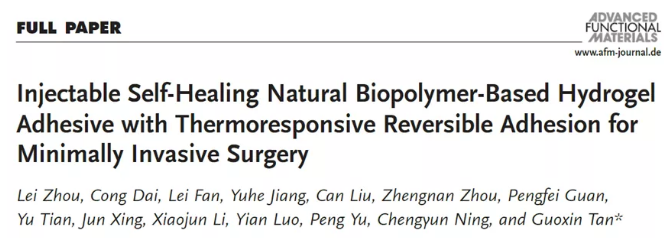
Results and discussion Synthesis and physical characterization of biopolymer hydrogels The injectable Gel–CS hydrogel bioadhesive is prepared by self-crosslinking CS and gelatin (Gel) oxidized by periodate in the presence of borax , Without adding any toxic cross-linking agent (Figure 1a). The absorption at 1725 cm-1 in FTIR is a C=O bond, confirming the formation of aldehyde groups (Figure 1b). In the 1H-NMR spectrum, there is a characteristic peak of aldehyde protons at 8.28 ppm in the modified CS, which further confirms the aldehyde group ( Figure 1c).
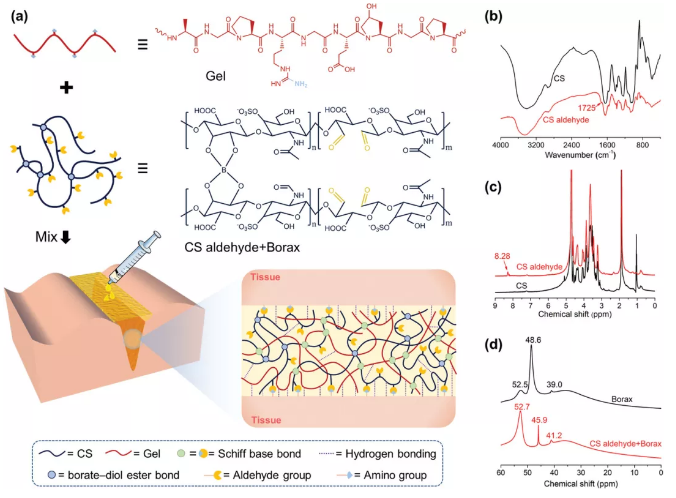
Figure 1. Gel-CS hydrogel adhesive. a) Schematic diagram of Gel-CS hydrogel formation and tissue adhesion at the same time. b) FTIR spectrum and c) 1H-NMR spectrum of CS and CS aldehyde. d) 11 B NMR spectrum of borax and CS aldehyde in borax. Gel time and mechanical properties of hydrogel The gel time of hydrogel is very important for its application in tissue adhesives and sealants. In general, by changing the molecular weight of CS, the biopolymer or borax The concentration can well control the gel time of the hydrogel at physiological temperature. For low, medium, and low molecular weight hydrogels, the gel time was 13.0, 3.0, and 0.8 minutes, respectively (Figure 2a). High dissolved oxygen promotes the crosslinking reaction rate between amino groups and aldehyde groups. The increased concentration of CS aldehyde and borax can reduce the gelation time. In addition, by changing the molecular weight of CS, the concentration of borax or the polymer, the mechanical properties of the hydrogel can be well controlled. At 37°C, hydrogels of different molecular weights are stable elastic solids (Figure 2b). Increasing dissolved oxygen can increase the mechanical strength of the gel (Figure 2b, c). Similarly, when maintaining a fixed high or moderate dissolved oxygen, the storage modulus will increase with the increase of gel, CS aldehyde or borax concentration due to the increase of cross-linking within the polymer network (Figure 2c). The hydrogel is also temperature-responsive (Figure 2d).
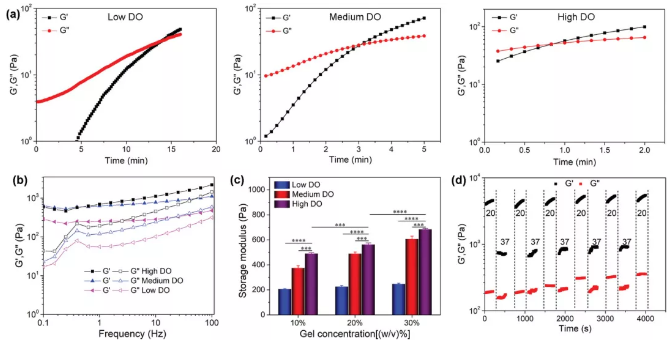
Figure 2. Mechanical properties of Gel-CS adhesive hydrogel. a) Dynamic time scan rheological analysis. b) Perform rheological analysis of Gel-CS hydrogel with different solubility in frequency sweep mode. c) The average storage modulus of Gel–CS hydrogels prepared with 10%, 20% and 30% (w/v) Gel and 10% (w/v) CS. d) Gel-CS hydrogel is scanned at 20 and 37°C shaking time. The self-healing ability of the hydrogel and the injectable hydrogel can withstand large elastic deformation, and maintain a stable modulus until the strain reaches 100%, until the strain reaches 750%, the hydrogel network breaks and transforms into a sol (Figure 3a). Once the strain returns to 5%, the gel will reform again (Figure 3b) without any loss of modulus. At 37°C, the viscosity of the hydrogel decreases as the shear rate increases (Figure 3c). This shear thinning behavior can be attributed to the shear-induced fracture of the dynamic hydrogel network, thereby enhancing the self-healing and injectability of the hydrogel. The two semi-disc hydrogels can be connected to each other without any external intervention at 37°C (Figure 3d). Even after applying external force to the hydrogel, the healed hydrogel can maintain its integrity (Figure 3e). The rapid self-healing mechanism of this biopolymer hydrogel is due to the dynamic covalent Schiff base network and reversible intermolecular hydrogen bonds (Figure 3f). In addition, due to the dynamic properties and shear thinning properties of the hydrogel network, it has good injectability (Figure 3g).
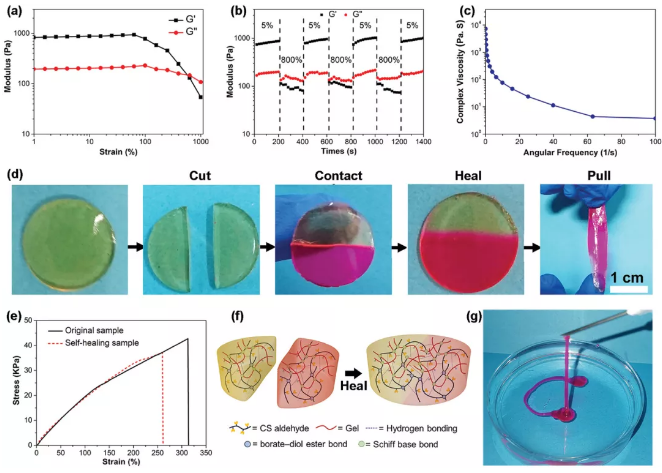
Figure 3. Self-healing and injection capabilities of Gel-CS hydrogel. a) Strain amplitude sweep test at 37°C fixed angular frequency. b) Fast self-healing performance of Gel-CS. c) Shear thinning test of hydrogel. d) Image of self-healing behavior of hydrogel. e) The stress-strain curves of the original hydrogel and the self-healing Gel-CS hydrogel after curing for 2 h. f) Schematic diagram of the self-repair mechanism. g) Pour the liquefied Gel-CS sample into 37°C deionized water. The adhesive properties and thermally responsive reversible adhesion of hydrogels. Hydrogels also show strong adhesion to various materials (such as pig skin tissue, rubber and glass) (Figure 4). At a fixed 10% (w/v) CS aldehyde concentration, with the increase of the gel concentration, the adhesive strength of the medium solubility gel to pig skin increased from 8.7 ± 1.2 to 21.2 ± 0.9 and 24.2 ± 1.5 kPa ( Figure 4c). The adhesion strength (30.64±0.9 kPa) of the gel-CS hydrogel with high dissolved oxygen and 30% (w/v) gel is the strongest (Figure 4d). The gel can also adhere to defective tissues to withstand the burst pressure imposed by body fluids (Figure 4e). The hydrogel has good thermal rheological reversibility, and the viscoelastic state of the gel can be controlled by local temperature changes to trigger reversible adhesion. At 20°C, the gel has low adhesion and can be separated from the surface of the object. At 37°C, the adhesion is high and objects can be re-adhesive through the gel. The state between the two is switchable (Figure 5).
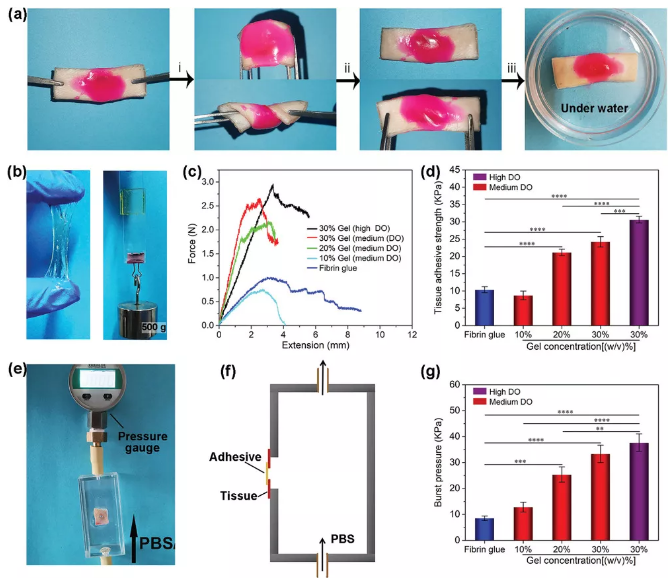
Figure 4 In vitro adhesion performance of Gel-CS hydrogel. a) Photograph of Gel-CS hydrogel attached to pig tissue in situ. b) Photo of hydrogel firmly adhered to gloves and glass. c) Representative lap shear bonding curves of various adhesives applied to pig skin. d) Compared with commercially available fibrin glue, the average adhesive strength of Gel-CS hydrogels produced under different gel concentrations and CS DO. e) Photograph and f) schematic diagram of the test equipment used for burst pressure measurement. . Figure 5. Thermally responsive reversible adhesion of Gel-CS hydrogel. a) The hydrogel adheres tightly to the finger skin surface at 37°C, but hardly adheres at 20°C. b) Photographs of the peeling test of hydrogel on pig skin tissue at 20 and 37°C. c) The binding energy of the hydrogel at 20 and 37°C. d) Photographs of the peeling process of two pieces of pig skin tissue adhered with hydrogel at 37°C, and e) The surface of the pig skin tissue was peeled at 20°C. f) Thermal bonding conversion mechanism. Hydrogels potential sealant application hemostatic material is essential to prevent uncontrolled bleeding during surgery, trauma and emergency situations. The gel has excellent hemostatic ability in the body. It can act as a physical barrier to prevent blood from seeping out and prevent the liver from being pierced by a syringe needle and causing severe bleeding. Its performance is much superior to commercial fibrin glue (Figure 6). This is because of the hemostatic components of gelatin, CS and aldehyde groups. Moreover, the gel can provide an effective liquid-tight seal for surgical damage in the body and protect tissue damage during postoperative healing. It is also a laparoscopic sealant for laparoscopic liver surgery.
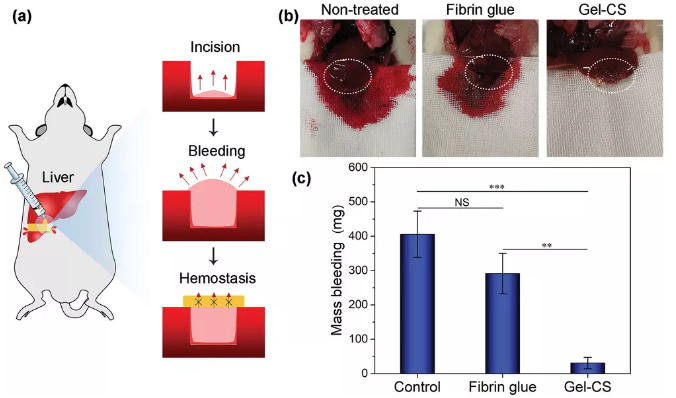

| Reminder: Beijing Beike New Material Technology Co., Ltd. supplies products only for scientific research, not for humans |
| All rights reserved © 2019 beijing beike new material Technology Co., Ltd 京ICP备16054715-2号 |